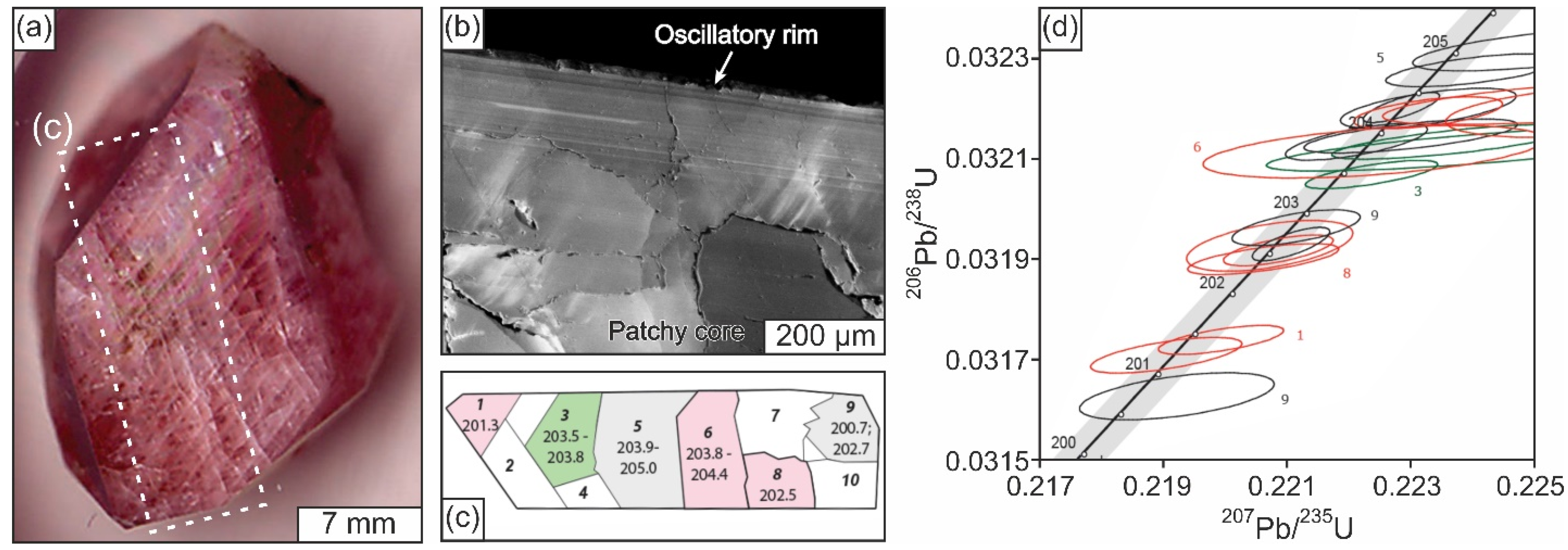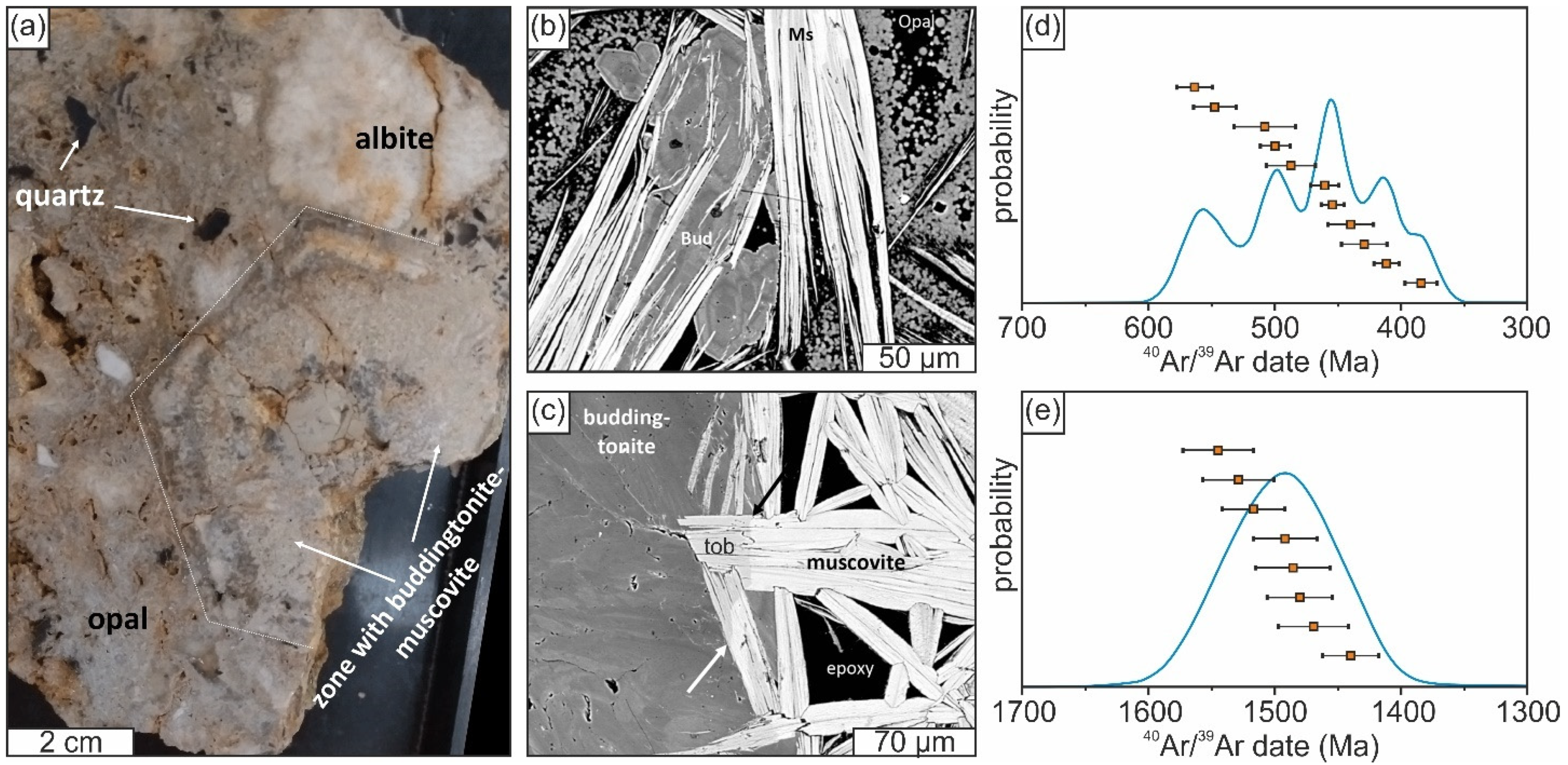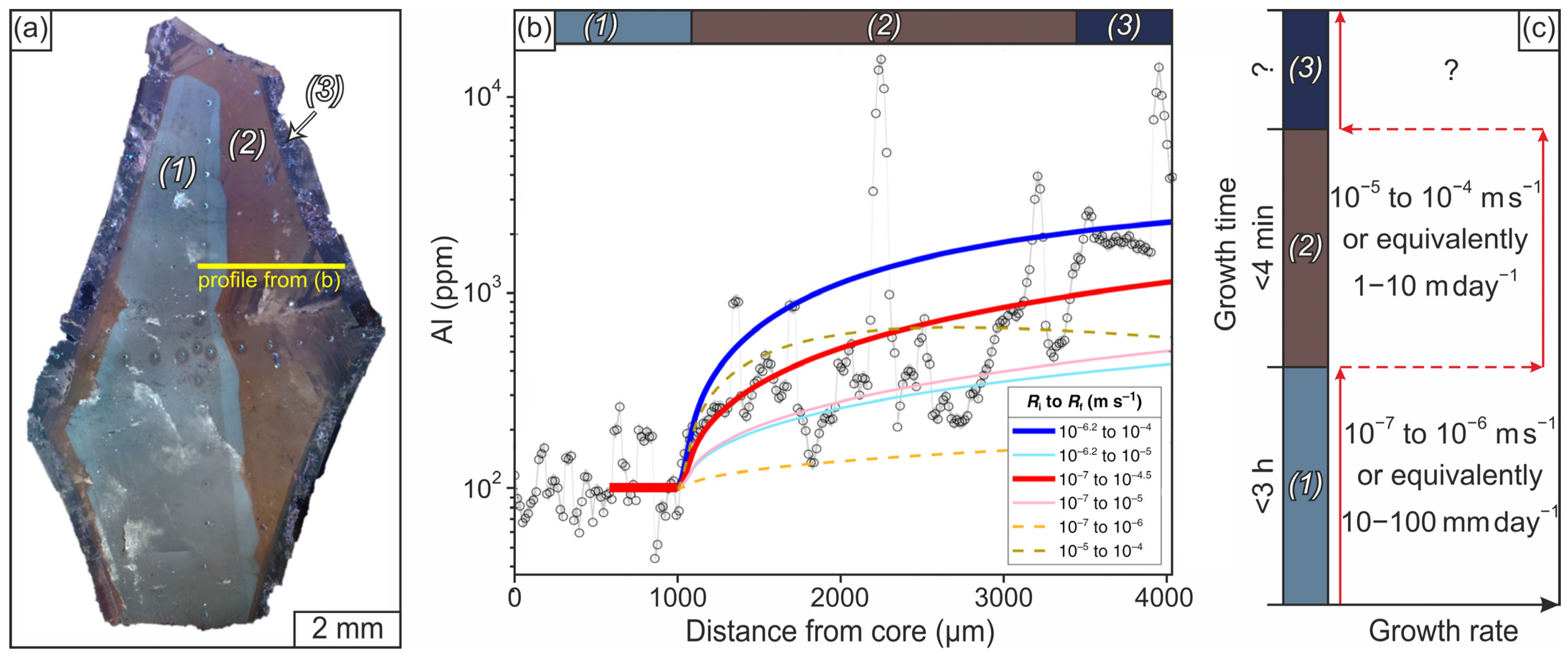Do Pegmatites Crystallise Fast? A Perspective from Petrologically-Constrained Isotopic Dating
Abstract
1. Introduction
2. Examples of Protracted (Re)Crystallisation in Pegmatites
2.1. Finero Pegmatites
2.2. Itrongay Pegmatite
2.3. Pakeagama Lake Pegmatite
2.4. Volyn Pegmatites
3. Discussion
4. Conclusions
Funding
Institutional Review Board Statement
Informed Consent Statement
Data Availability Statement
Acknowledgments
Conflicts of Interest
References
- London, D. A Petrologic Assessment of Internal Zonation in Granitic Pegmatites. Lithos 2014, 184–187, 74–104. [Google Scholar] [CrossRef]
- Simmons, W.B.; Pezzotta, F.; Shigley, J.E.; Beurlen, H. Granitic Pegmatites as Sources of Colored Gemstones. Elements 2012, 8, 281–287. [Google Scholar] [CrossRef]
- Glover, A.S.; Rogers, W.Z.; Barton, J.E. Granitic Pegmatites: Storehouses of Industrial Minerals. Elements 2012, 8, 269–273. [Google Scholar] [CrossRef]
- Linnen, R.L.; Van Lichtervelde, M.; Černý, P. Granitic Pegmatites as Sources of Strategic Metals. Elements 2012, 8, 275–280. [Google Scholar] [CrossRef]
- Troch, J.; Huber, C.; Bachmann, O. The Physical and Chemical Evolution of Magmatic Fluids in Near-Solidus Silicic Magma Reservoirs: Implications for the Formation of Pegmatites. Am. Mineral. 2022, 107, 190–205. [Google Scholar] [CrossRef]
- Thomas, R.; Davidson, P. Comment on “A Petrologic Assessment of Internal Zonation in Granitic Pegmatites” by David London (2014). Lithos 2015, 212–215, 462–468. [Google Scholar] [CrossRef]
- Smirnov, S.Z. The Fluid Regime of Crystallization of Water-Saturated Granitic and Pegmatitic Magmas: A Physicochemical Analysis. Russ. Geol. Geophys. 2015, 56, 1292–1307. [Google Scholar] [CrossRef]
- Popov, D.V.; Spikings, R.A.; Razakamanana, T. Inclusions of Amorphous and Crystalline SiO₂ in Minerals from Itrongay (Madagascar) and Other Evidence for the Natural Occurrence of Hydrosilicate Fluids. Geosciences 2022, 12, 28. [Google Scholar] [CrossRef]
- Romer, R.L.; Smeds, S.-A. U-Pb Columbite Chronology of Post-Kinematic Palaeoproterozoic Pegmatites in Sweden. Precambrian Res. 1997, 82, 85–99. [Google Scholar] [CrossRef]
- Müller, A.; Romer, R.L.; Pedersen, R.-B. The Sveconorwegian Pegmatite Province—Thousands of Pegmatites Without Parental Granites. Can. Mineral. 2017, 55, 283–315. [Google Scholar] [CrossRef]
- Kontak, D.J.; Creaser, R.A.; Heaman, L.M.; Archibald, D.A. U-Pb Tantalite, Re-Os Molybdenite, and 40Ar/39Ar Muscovite Dating of the Brazil Lake Pegmatite, Nova Scotia: A Possible Shear-Zone Related Origin for an LCT-Type Pegmatite. Atl. Geol. 2005, 41, 17–29. [Google Scholar] [CrossRef] [PubMed]
- Shaw, R.A.; Goodenough, K.M.; Roberts, N.M.W.; Horstwood, M.S.A.; Chenery, S.R.; Gunn, A.G. Petrogenesis of Rare-Metal Pegmatites in High-Grade Metamorphic Terranes: A Case Study from the Lewisian Gneiss Complex of North-West Scotland. Precambrian Res. 2016, 281, 338–362. [Google Scholar] [CrossRef]
- Melleton, J.; Gloaguen, E.; Frei, D.; Novak, M.; Breiter, K. How Are the Emplacement of Rare-Element Pegmatites, Regional Metamorphism and Magmatism Interrelated in the Moldanubian Domain of the Variscan Bohemian Massif, Czech Republic? Can. Mineral. 2012, 50, 1751–1773. [Google Scholar] [CrossRef]
- Lv, Z.-H.; Zhang, H.; Tang, Y. Anatexis Origin of Rare Metal/Earth Pegmatites: Evidences from the Permian Pegmatites in the Chinese Altai. Lithos 2021, 380–381, 105865. [Google Scholar] [CrossRef]
- Simmons, W.B.; Webber, K.L. Pegmatite Genesis: State of the Art. Eur. J. Mineral. 2008, 20, 421–438. [Google Scholar] [CrossRef]
- Webber, K.L.; Simmons, W.B.; Falster, A.U.; Foord, E.E. Cooling Rates and Crystallization Dynamics of Shallow Level Pegmatite-Aplite Dikes, San Diego County, California. Am. Mineral. 1999, 84, 708–717. [Google Scholar] [CrossRef]
- Webber, K.L.; Falster, A.U.; Simmons, W.B.; Foord, E.E. The Role of Diffusion-Controlled Oscillatory Nucleation in the Formation of Line Rock in Pegmatite-Plite Dikes. J. Petrol. 1997, 38, 1777–1791. [Google Scholar] [CrossRef]
- Bradley, D.; Shea, E.; Buchwaldt, R.; Bowring, S.; Benowitz, J.; O’Sullivan, P.; McCauley, A. Geochronology and Tectonic Context of Lithium-Cesium-Tantalum Pegmatites In the Appalachians. Can. Mineral. 2016, 54, 945–969. [Google Scholar] [CrossRef]
- Mauthner, M.H.F.; Mortensen, J.K.; Groat, L.A.; Ercit, T.S. Geochronology of the Little Nahanni Pegmatite Group, Selwyn Mountains, Southwestern Northwest Territories. Can. J. Earth Sci. 1995, 32, 2090–2097. [Google Scholar] [CrossRef]
- McCauley, A.; Bradley, D.C. The Global Age Distribution of Granitic Pegmatites. Can. Mineral. 2014, 52, 183–190. [Google Scholar] [CrossRef]
- Melcher, F.; Graupner, T.; Gäbler, H.-E.; Sitnikova, M.; Henjes-Kunst, F.; Oberthür, T.; Gerdes, A.; Dewaele, S. Tantalum–(Niobium–Tin) Mineralisation in African Pegmatites and Rare Metal Granites: Constraints from Ta–Nb Oxide Mineralogy, Geochemistry and U–Pb Geochronology. Ore Geol. Rev. 2015, 64, 667–719. [Google Scholar] [CrossRef]
- Tkachev, A.V. Evolution of Metallogeny of Granitic Pegmatites Associated with Orogens throughout Geological Time. Geol. Soc. Lond. Spec. Publ. 2011, 350, 7–23. [Google Scholar] [CrossRef]
- Wang, H.-Y.; Tang, Y.; Zhang, H.; Lv, Z.-H.; Xu, Y.-S. The Geochronology of the Rare Metal Pegmatite Deposits: A Case Study in Nanping No. 31 Pegmatite Vein in Northeastern Cathaysian Block, China. Ore Geol. Rev. 2023, 153, 105280. [Google Scholar] [CrossRef]
- Sun, W.; Zhao, Z.; Mo, X.; Wei, C.; Dong, G.; Li, X.; Yuan, W.; Wang, T.; Yang, S.; Wang, B.; et al. Age and Composition of Columbite-Tantalite Group Minerals in the Spodumene Pegmatite from the Chakabeishan Deposit, Northern Tibetan Plateau and Their Implications. Minerals 2023, 13, 201. [Google Scholar] [CrossRef]
- Konzett, J.; Schneider, T.; Nedyalkova, L.; Hauzenberger, C.; Melcher, F.; Gerdes, A.; Whitehouse, M. Anatectic Granitic Pegmatites from the Eastern Alps: A Case of Variable Rare-Metal Enrichment During High-Grade Regional Metamorphism—I: Mineral Assemblages, Geochemical Characteristics, and Emplacement Ages. Can. Mineral. 2018, 56, 555–602. [Google Scholar] [CrossRef]
- Bryden, C.D.; Jamieson, R.A.; Luo, Y.; Fisher, C.M.; Pearson, D.G. Geochronology of Scapolite Pegmatites from the Nordøyane Ultra-High-Pressure Domain, Western Gneiss Region, Norway: Protracted Crystal-Melt Reaction during Scandian Exhumation. Lithos 2022, 424–425, 106756. [Google Scholar] [CrossRef]
- Feng, Y.; Jiang, S.-Y.; Wang, C.-L.; Jin, G.; Zhang, J.; Zhang, H.-X.; Hu, X.-J. U–Pb Geochronology of Columbite-Group Mineral, Cassiterite, and Zircon and Hf Isotopes for Devonian Rare-Metal Pegmatite in the Nanyangshan Deposit, North Qinling Orogenic Belt, China. Ore Geol. Rev. 2022, 140, 104634. [Google Scholar] [CrossRef]
- Smith, S.R.; Foster, G.L.; Romer, R.L.; Tindle, A.G.; Kelley, S.P.; Noble, S.R.; Horstwood, M.; Breaks, F.W. U-Pb Columbite-Tantalite Chronology of Rare-Element Pegmatites Using TIMS and Laser Ablation-Multi Collector-ICP-MS. Contrib. Mineral. Petrol. 2004, 147, 549–564. [Google Scholar] [CrossRef]
- Smith, S.R.; Kelley, S.P.; Tindle, A.G.; Breaks, F.W. Compositional Controls on 40Ar/39Ar Ages of Zoned Mica from a Rare-Element Pegmatite. Contrib. Mineral. Petrol. 2005, 149, 613–626. [Google Scholar] [CrossRef]
- Schaltegger, U.; Ulianov, A.; Muntener, O.; Ovtcharova, M.; Peytcheva, I.; Vonlanthen, P.; Vennemann, T.; Antognini, M.; Girlanda, F. Megacrystic Zircon with Planar Fractures in Miaskite-Type Nepheline Pegmatites Formed at High Pressures in the Lower Crust (Ivrea Zone, Southern Alps, Switzerland). Am. Mineral. 2015, 100, 83–94. [Google Scholar] [CrossRef]
- Popov, D.V.; Spikings, R.A.; Scaillet, S.; O’Sullivan, G.; Chew, D.; Badenszki, E.; Daly, J.S.; Razakamanana, T.; Davies, J.H.F.L. Diffusion and Fluid Interaction in Itrongay Pegmatite (Madagascar): Evidence from in Situ 40Ar/39Ar Dating of Gem-Quality Alkali Feldspar and U-Pb Dating of Protogenetic Apatite Inclusions. Chem. Geol. 2020, 556, 119841. [Google Scholar] [CrossRef]
- Franz, G.; Sudo, M.; Khomenko, V. 40Ar/39Ar Dating of a Hydrothermal Pegmatitic Buddingtonite–Muscovite Assemblage from Volyn, Ukraine. Eur. J. Mineral. 2022, 34, 7–18. [Google Scholar] [CrossRef]
- Naumenko-Dèzes, M.O.; Villa, I.M.; Rolland, Y.; Gallet, S.; Lanari, P. Subgrain 40Ar/39Ar Dating of Museum-Quality Micas Reveals Intragrain Heterogeneity. Chem. Geol. 2021, 573, 120215. [Google Scholar] [CrossRef]
- Michallik, R.M.; Wagner, T.; Fusswinkel, T.; Heinonen, J.S.; Heikkilä, P. Chemical Evolution and Origin of the Luumäki Gem Beryl Pegmatite: Constraints from Mineral Trace Element Chemistry and Fractionation Modeling. Lithos 2017, 274–275, 147–168. [Google Scholar] [CrossRef]
- Dill, H.G.; Skoda, R.; Weber, B.; Müller, A.; Berner, Z.A.; Wemmer, K.; Balaban, S.-I. Mineralogical and Chemical Composition of the Hagendorf-North Pegmatite, SE Germany—A Monographic Study. Neues Jahrb. Für Mineral. Abh. 2013, 190, 281–318. [Google Scholar] [CrossRef]
- Zagorsky, V.Y. Sosedka Pegmatite Body at the Malkhan Deposit of Gem Tourmaline, Transbaikalia: Composition, Inner Structure, and Petrogenesis. Petrology 2015, 23, 68–92. [Google Scholar] [CrossRef]
- Lacroix, A. Note Préliminaire Sur Quelques Minéraux de Madagascar Dont Plusieurs Peuvent Être Utilisés Comme Gemmes. Comptes Rendus Hebd. Séances L’académie Sci. 1912, 155, 672–677. [Google Scholar]
- Nägler, T.F.; Villa, I.M. In Pursuit of the 40K Branching Ratios: K-Ca and 39Ar–40Ar Dating of Gem Silicates. Chem. Geol. 2000, 169, 5–16. [Google Scholar] [CrossRef]
- Simmons, W.B.; Falster, A.U. Yellow Orthoclase (Sanidine) from South Betroka, Madagascar. Mineral. Rec. 2002, 33, 79–80. [Google Scholar]
- Parsons, I.; Lee, M.R. Minerals Are Not Just Chemical Compounds. Can. Mineral. 2005, 43, 1959–1992. [Google Scholar] [CrossRef]
- Flude, S.; Halton, A.M.; Kelley, S.P.; Sherlock, S.C.; Schwanethal, J.; Wilkinson, C.M. Observation of Centimetre-Scale Argon Diffusion in Alkali Feldspars: Implications for 40Ar/39Ar Thermochronology. Geol. Soc. Lond. Spec. Publ. 2014, 378, 265–275. [Google Scholar] [CrossRef]
- Spikings, R.A.; Popov, D.V. Thermochronology of Alkali Feldspar and Muscovite at T > 150 °C Using the 40Ar/39Ar Method: A Review. Minerals 2021, 11, 1025. [Google Scholar] [CrossRef]
- Halama, R.; Glodny, J.; Konrad-Schmolke, M.; Sudo, M. Rb-Sr and in Situ 40Ar/39Ar Dating of Exhumation-Related Shearing and Fluid-Induced Recrystallization in the Sesia Zone (Western Alps, Italy). Geosphere 2018, 14, 1425–1450. [Google Scholar] [CrossRef]
- Villa, I.M.; Glodny, J.; Peillod, A.; Skelton, A.; Ring, U. Petrochronology of Polygenetic White Micas (Naxos, Greece). J. Metamorph. Geol. 2023, 41, 401–423. [Google Scholar] [CrossRef]
- Nteme, J.; Scaillet, S.; Brault, P.; Tassan-Got, L. Atomistic Simulations of 40Ar Diffusion in Muscovite. Geochim. Cosmochim. Acta 2022, 331, 123–142. [Google Scholar] [CrossRef]
- Roedder, E. Fluid Inclusion Evidence for Immiscibility in Magmatic Differentiation. Geochim. Cosmochim. Acta 1992, 56, 5–20. [Google Scholar] [CrossRef]
- Thomas, R.; Davidson, P.; Hahn, A. Ramanite-(Cs) and Ramanite-(Rb): New Cesium and Rubidium Pentaborate Tetrahydrate Minerals Identified with Raman Spectroscopy. Am. Mineral. 2008, 93, 1034–1042. [Google Scholar] [CrossRef]
- Franz, G.; Khomenko, V.; Vishnyevskyy, A.; Wirth, R.; Struck, U.; Nissen, J.; Gernert, U.; Rocholl, A. Biologically Mediated Crystallization of Buddingtonite in the Paleoproterozoic: Organic-Igneous Interactions from the Volyn Pegmatite, Ukraine. Am. Mineral. 2017, 102, 2119–2135. [Google Scholar] [CrossRef][Green Version]
- Franz, G.; Lyckberg, P.; Khomenko, V.; Chournousenko, V.; Schulz, H.-M.; Mahlstedt, N.; Wirth, R.; Glodny, J.; Gernert, U.; Nissen, J. Fossilization of Precambrian Microfossils in the Volyn Pegmatite, Ukraine. Biogeosciences 2022, 19, 1795–1811. [Google Scholar] [CrossRef]
- Shumlyanskyy, L.; Hawkesworth, C.; Billström, K.; Bogdanova, S.; Mytrokhyn, O.; Romer, R.; Dhuime, B.; Claesson, S.; Ernst, R.; Whitehouse, M.; et al. The Origin of the Palaeoproterozoic AMCG Complexes in the Ukrainian Shield: New U-Pb Ages and Hf Isotopes in Zircon. Precambrian Res. 2017, 292, 216–239. [Google Scholar] [CrossRef]
- Shumlyanskyy, L.; Franz, G.; Glynn, S.; Mytrokhyn, O.; Voznyak, D.; Bilan, O. Geochronology of Granites of the Western Korosten AMCG Complex (Ukrainian Shield): Implications for the Emplacement History and Origin of Miarolitic Pegmatites. Eur. J. Mineral. 2021, 33, 703–716. [Google Scholar] [CrossRef]
- Putnis, A. Mineral Replacement Reactions. Rev. Mineral. Geochem. 2009, 70, 87–124. [Google Scholar] [CrossRef]
- Villa, I.M. Diffusion in Mineral Geochronometers: Present and Absent. Chem. Geol. 2016, 420, 1–10. [Google Scholar] [CrossRef]
- Mark, D.F.; Kelley, S.P.; Lee, M.R.; Parnell, J.; Sherlock, S.C.; Brown, D.J. Ar–Ar Dating of Authigenic K-Feldspar: Quantitative Modelling of Radiogenic Argon-Loss through Subgrain Boundary Networks. Geochim. Cosmochim. Acta 2008, 72, 2695–2710. [Google Scholar] [CrossRef]
- Popov, D.V.; Spikings, R.A.; Kouzmanov, K. Pathways for 39Ar Loss during Step-Heating of Alkali Feldspar Megacrysts from the Shap Granite (UK): Combined Evidence from Diffusion Experiments and Characterisation of Heating-Induced Texture Modifications. Chem. Geol. 2020, 547, 119677. [Google Scholar] [CrossRef]
- Scibiorski, E.; Jourdan, F.; Mezger, K.; Tohver, E.; Vollstaedt, H. Cryptic Excess Argon in Metamorphic Biotite: Anomalously Old 40Ar/39Ar Plateau Dates Tested with Rb/Sr Thermochronology and Ar Diffusion Modelling. Geochim. Cosmochim. Acta 2021, 315, 1–23. [Google Scholar] [CrossRef]
- Popov, D.; Spikings, R.; Ovtcharova, M.; O’Sullivan, G.; Chew, D.; Badenszki, E.; Daly, S.; Davies, J.; Chiaradia, M.; Ulianov, A. Multi-Method Approach to Understanding the Migration Mechanisms of Pb in Apatite and Ar in Alkali Feldspar from Proterozoic Granitic Batholiths from the Mt. Isa Inlier (Australia). In Proceedings of the Goldschmidt Conference 2021, Virtual, 4–9 July 2021. [Google Scholar]
- London, D. An Experimental Crystallization Of The Macusani Obsidian In A Thermal Gradient With Applications To Lithium-Rich Granitic Pegmatites. Am. Mineral. in press. [CrossRef]
- Phelps, P.R.; Lee, C.-T.A.; Morton, D.M. Episodes of Fast Crystal Growth in Pegmatites. Nat. Commun. 2020, 11, 4986. [Google Scholar] [CrossRef]
- Burton, J.A.; Prim, R.C.; Slichter, W.P. The Distribution of Solute in Crystals Grown from the Melt. Part I. Theoretical. J. Chem. Phys. 1953, 21, 1987–1991. [Google Scholar] [CrossRef]
- Smith, V.G.; Tiller, W.A.; Rutter, J.W. A Mathimatica Analysis of Solute Redistribution during Solidification. Can. J. Phys. 1955, 33, 723–745. [Google Scholar] [CrossRef]





Disclaimer/Publisher’s Note: The statements, opinions and data contained in all publications are solely those of the individual author(s) and contributor(s) and not of MDPI and/or the editor(s). MDPI and/or the editor(s) disclaim responsibility for any injury to people or property resulting from any ideas, methods, instructions or products referred to in the content. |
© 2023 by the author. Licensee MDPI, Basel, Switzerland. This article is an open access article distributed under the terms and conditions of the Creative Commons Attribution (CC BY) license (https://creativecommons.org/licenses/by/4.0/).
Share and Cite
Popov, D.V. Do Pegmatites Crystallise Fast? A Perspective from Petrologically-Constrained Isotopic Dating. Geosciences 2023, 13, 297. https://doi.org/10.3390/geosciences13100297
Popov DV. Do Pegmatites Crystallise Fast? A Perspective from Petrologically-Constrained Isotopic Dating. Geosciences. 2023; 13(10):297. https://doi.org/10.3390/geosciences13100297
Chicago/Turabian StylePopov, Daniil V. 2023. "Do Pegmatites Crystallise Fast? A Perspective from Petrologically-Constrained Isotopic Dating" Geosciences 13, no. 10: 297. https://doi.org/10.3390/geosciences13100297
APA StylePopov, D. V. (2023). Do Pegmatites Crystallise Fast? A Perspective from Petrologically-Constrained Isotopic Dating. Geosciences, 13(10), 297. https://doi.org/10.3390/geosciences13100297





